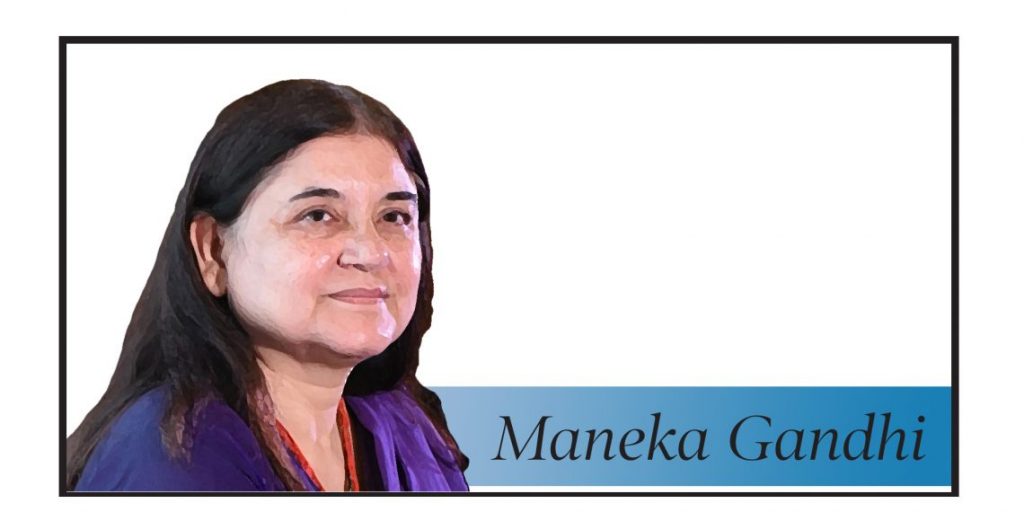In Pilibhit, as in most districts of the Tarai, a large number of vehicles are still horse-drawn. This is not just true of this area, but over most northern states. There are horses being used in Delhi as well — even though we have had them banned from most parts of the city.
I have a People For Animals hospital in Bareilly, and not a day passes when my team does not get a call from all the neighbouring districts to pick up a horse which has been in an accident, broken its leg because of the unevenness of the dreadful village roads, or has simply been abandoned because it collapsed from general weakness and an overload of passengers. Many horses lose their hooves because they are badly shod. Their feet swell and develop gangrene. Many horses have the dreaded disease glanders and are undiagnosed and untreated till they fall and die.
Some horses have bruised eyes from the constant hitting, and swollen legs from nails that make holes in their hooves and go right into the bone. Health assessment reports, done for PETA by a team of government veterinarians from the Maharashtra Department of Animal Husbandry on local working horses, found that they were all suffering from malnourishment, wounds all over their bodies, inflamed tendons, ligaments and joints. The veterinarians stated that if the horses were put to work again, their painful ailments would likely worsen to the point of permanent disability. A field clinic, done by Welttierschutzgesellschaft e. V. and IPAN in Ooty, showed 350 horses suffering from traumatic injuries and hoof problems caused by poor hoof trimming or incorrect shoeing.
Many equines at blood-extracting facilities suffer from anaemia, and untreated wounds, diseased hooves, malnourishment, infections, parasites, swollen limbs, lameness, and eye abnormalities.
No horse is kept by their owner in a covered area. In Pilibhit, I see them tied to stakes at the edge of roads. They have no way to protect themselves from the burning heat of the sun, heavy rainfall or the extreme cold of winter. They get no fresh water, and their food comes in a bag tied round their neck, which they can eat between passenger stops.
The risk of traffic accidents is huge. The search for fresh grass also poses deadly dangers for the animals. Horses need to spend up to 18 hours a day eating. The subsequent chewing of the food contributes to their well-being. But, since they are rarely let free from work, they have no time to eat or forage, and end up near overflowing rubbish. By eating food scraps found in rubbish bins, they also consume plastic parts, which, over time form an indigestible plastic lump in the stomach, ending up with intestinal obstruction and intestinal perforation.
Many horses are impregnated forcibly. The mother and foal don’t stay very long together, as the foal is sold.
The white mare is used for the most hellish purpose: The Indian marriage baraat. The violently loud music, the screaming and dancing crowd, the muzzle on her face, the hours of walking and waiting, the chomping on an iron bit that breaks her teeth . . . imagine the fear and pain that the horse goes through. Many horses are so traumatised that they bite their tongues and cannot chew food for weeks after that.
No horse gets any medical help. Not only are the government veterinarians untrained in horses (or any other animal) but all the local veterinary clinics have no equipment or medicine. They do practically nothing. If you want to wish for a job which pays excellently and in which you have to do nothing, pray to be a government vet in India. So how do we solve this problem?
India has about 12 lakh working horses and mules. They are overworked, underfed, underwatered and never treated for ailments. It is about time we regulated this. I made the laws on how many people could sit on a horse-drawn cart, thirty years ago. They have been completely ignored by the local police and administrative departments. Technically, not more than four people can sit. But I have never seen less than 15.
What is needed is a regulatory regime that brings in money. That money can be spent on shoring horses properly, giving them a regular check up with deworming and anti-tetanus injections. Farriers can be trained in proper hoof care. I have suggested to the DM of Pilibhit that he make it compulsory for every horse owner to register his horse, and the registration is to be renewed annually. He will have to pay some money, and this will be used to give the horse a complete check-up and the necessary medicines, including shoeing the animal. Unlicenced horses will be confiscated. If the horses of an owner die too soon, he can be banned from keeping more horses.
This will achieve a minimum level of care for the animals and make the owner responsible. It will bring some money to the administration of each district’s veterinary hospital and hopefully, it will act as a deterrent for keeping/using horses. I hope to see this practice complete
during my lifetime.
The first horse emerged from the depth of the ocean during the churning of the ocean. Called Ichchaihshravas, the winged horse was taken by Indra to Svarga. His descendants were wingless and were sent to earth. One of the famous avatars of Vishnu is Hayagriva, the horse headed, and he stands for Knowledge. How sad that his descendants have become such pathetic victims of man’s cruelty.
To join the animal welfare movement, contact gandhim@nic.in, www.peopleforanimalsindia.org.
